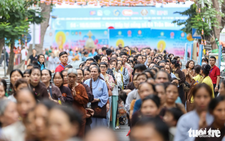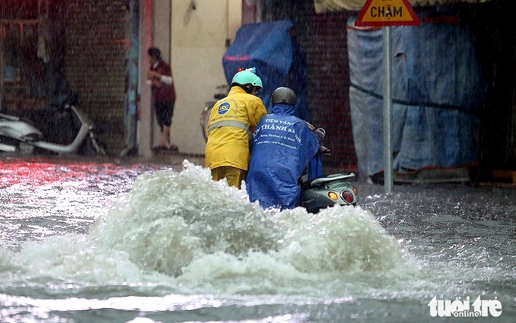Vietnamese PM meets US enterprises to enhance cooperation
Economy 6 hours agoPrime Minister Pham Minh Chinh convened a meeting in Hanoi on Tuesday with representatives from the U.S. business community in Vietnam, aiming to address concerns and explore avenues to enhance bilateral investment and trade cooperation.
Making ‘every family has two children’ more than just a slogan in Vietnam
In-Depth 3 hours agoHo Chi Minh City is among the first localities in Vietnam to record a birth rate below the replacement level and is now facing the risk of population aging.
Da Nang pours over $3.8mn into An Thuong ‘Western Area’ development
Travel 3 hours agoDa Nang, the capital city of central Vietnam, has announced a new investment of more than VND100 billion (US$3.8 million) in the second phase of the An Thuong tourist area development project, known as ‘Western Area.’
Vietnam’s Mekong Delta steps up airport expansions to unlock regional growth
Economy 3 minutes agoSeveral provinces in Vietnam’s Mekong Delta are accelerating airport upgrades to boost tourism and prepare for major events, in line with Prime Minister Pham Minh Chinh’s push for regional economic breakthroughs.
Vietnamese students strike gold win at world's toughest chemistry competition
Education 16 hours agoAll four Vietnamese students competing in the 59th International Mendeleev Chemistry Olympiad, known as the world's toughest chemistry...
Vietnam’s elementary students among SE Asia top in math, reading, writing
Education 3 days agoVietnamese elementary students continue to rank among the top in Southeast Asia across three core subjects, mathematics, reading comprehension,...
All 8 Vietnamese students win medals at 2025 Asian Physics Olympiad
Education 3 days agoAll eight members of the Vietnamese team competing at the 2025 Asian Physics Olympiad bagged medals, including three golds, three silvers, and...
18 schools from New Zealand to offer free STEM lessons to Vietnamese students next weekend
Education 6 days agoEighteen top educational institutions from Christchurch, New Zealand will offer free STEM (science, technology, engineering, and mathematics) lessons...
Is digital music a lucrative business for artists in Vietnam?
In-Depth 1 hour agoVietnam's digital music market is growing rapidly, yet revenue from streaming remains just a small piece for performers in this complex ecosystem, which is constantly evolving with challenges in copyright, workforce, and emerging technologies.
Vietnam, Russia aim to deepen strategic cooperation in fuel, nuclear energy
In-Depth 15 hours agoVietnam and Russia have agreed to deepen cooperation in strategic sectors of nuclear energy, oil and gas, and semiconductors following Vietnamese Party General Secretary To Lam’s state visit to Russia from May 8 to 11.
From 264kg to 98kg: Young Vietnamese man stuns with dramatic weight-loss journey
In-Depth 4 days agoTrong Nhan, a 29-year-old from Ho Chi Minh City, has amazed many with his incredible transformation—shedding more than 130 kilograms in just 16 months after once weighing as much as 264kg.
Vietnam needs comprehensive strategy for semiconductor industry
In-Depth 8 days agoThe semiconductor equipment industry – often simply referred to as the semiconductor or chip industry – has been and continues to play a critical role in specific industrial sectors and the Vietnamese economy at large.
Peace Festival in Vietnam
In-Depth 10 days agoThere was something refreshingly new about the recent celebrations marking the 50th anniversary of national reunification, compared to previous grand commemorations.
Metro crowds signal new rhythm for old habit in Ho Chi Minh City
In-Depth 11 days agoThis year's Reunification Day holiday has marked a notable shift in Ho Chi Minh City, as the usual traffic chaos gave way to a more orderly scene, with thousands of residents choosing to travel by metro.
In the heat of Ho Chi Minh City, a team is crafting sake with Vietnam’s globally acclaimed rice
In-Depth 12 days agoThere are many ways for a restaurant to leave a lasting impression on diners: online reviews, word-of-mouth recommendations, massive advertising campaigns, or sometimes just a sake drink that unexpectedly sparks curiosity.
Vietnam on track to strengthen position in AI era
In-Depth 15 days agoFifty years after national reunification, Vietnam is stepping into the digital age, with Vietnamese people at home and abroad joining forces to build a stronger, more prosperous nation.

Vietnam Airlines to move domestic flights to new terminal at Ho Chi Minh City airport from this weekend
Ho Chi Minh City 7 hours agoVietnam Airlines will shift all domestic flight operations at Tan Son Nhat International Airport in Ho Chi Minh City to the newly-opened T3 terminal from...

The volunteer firefighters warding off Greece's blazes
World 7 hours agoATHENS -- In summer 2023, Dimitris Marinelis spent days on the frontline of Europe's biggest wildfire in northern Greece, protecting homes and setting...

Vietnam PM vows to fight against counterfeits, trade frauds
Economy 6 hours agoHANOI -- Vietnam's Prime Minister Pham Minh Chinh on Wednesday urged the country's anti-counterfeit task force to devise new ways to fight fake...

Enhancing diagnostic, prevention, treatment capabilities in asthma management in Vietnam
Vietnam News 6 hours agoVietnam Respiratory Society, in collaboration with GSK Vietnam, recently organized a symposium named ‘Responding to World Asthma Day 2025’ to...

At Hanoi pagoda, throngs of Buddhists, residents queue to venerate Buddha relic from India
Vietnam News 6 hours agoThousands of Buddhists and locals formed a seemingly endless line along the streets outside Quan Su Pagoda in Hanoi from as early as 5:00 am...

Over 12 million Vietnamese carry gene for thalassemia: hematology institute
Vietnam News 4 hours agoMore than 12 million people in Vietnam carry the gene for thalassemia, a genetic blood disorder, including over 20,000 with severe forms of the disease...

Vietnamese student returns nearly $2,400 of lost cash to owner
Vietnam News 4 hours agoAn 11-year-old student in Ha Tinh Province, north-central Vietnam has returned VND61 million (US$2,350) of lost cash to its rightful owner, a local...

EU riles nuclear industry with delay to 'low-carbon' hydrogen rules
World 3 hours agoEuropean Union draft plans to wait until 2028 to classify hydrogen produced from nuclear power as a "low carbon" fuel, risk knee-capping the market for...

Nearly 20 tonnes of dead fish, waste removed from Ho Chi Minh City canal after first rains
Ho Chi Minh City 3 hours agoCleanup crews have collected nearly 20 metric tons of dead fish, water hyacinths, and trash from Ho Chi Minh City's Nhieu Loc-Thi Nghe Canal following...

Funding cuts leave women's aid organizations 'stretched to brink'
World 2 hours agoGENEVA -- Funding cuts have hit aid organizations that help the world's most vulnerable women especially hard, with over half of those surveyed at risk...

Is digital music a lucrative business for artists in Vietnam?
In-Depth 1 hour agoVietnam's digital music market is growing rapidly, yet revenue from streaming remains just a small piece for performers in this complex ecosystem, which...

Enhancing diagnostic, prevention, treatment capabilities in asthma management in Vietnam
Vietnam News 6 hours agoVietnam Respiratory Society, in collaboration with GSK Vietnam, recently organized a symposium named ‘Responding to World Asthma Day 2025’ to share knowledge and the latest advancements in preventing and treating the condition to propose effective solutions for asthma management in the Southeast Asian country.

At Hanoi pagoda, throngs of Buddhists, residents queue to venerate Buddha relic from India
Vietnam News 6 hours agoThousands of Buddhists and locals formed a seemingly endless line along the streets outside Quan Su Pagoda in Hanoi from as early as 5:00 am on Wednesday, patiently waiting to enter and pay homage to the sacred relic of the Buddha from India.

Over 12 million Vietnamese carry gene for thalassemia: hematology institute
Vietnam News 4 hours agoMore than 12 million people in Vietnam carry the gene for thalassemia, a genetic blood disorder, including over 20,000 with severe forms of the disease who require lifelong treatment, according to the National Institute of Hematology and Blood Transfusion.

Vietnamese student returns nearly $2,400 of lost cash to owner
Vietnam News 4 hours agoAn 11-year-old student in Ha Tinh Province, north-central Vietnam has returned VND61 million (US$2,350) of lost cash to its rightful owner, a local official confirmed on Tuesday.

Key to Vietnam's success in becoming first country to breed amberjack
Vietnam News 13 minutes agoIn its first attempt, Vietnam has succeeded in breeding the high-value amberjack, a feat no other country has accomplished to date.

Vietnam Airlines to move domestic flights to new terminal at Ho Chi Minh City airport from this weekend
Ho Chi Minh City 7 hours agoVietnam Airlines will shift all domestic flight operations at Tan Son Nhat International Airport in Ho Chi Minh City to the newly-opened T3 terminal from 4:00 am on Saturday, following more than 20 days of pilot operations.

Nearly 20 tonnes of dead fish, waste removed from Ho Chi Minh City canal after first rains
Ho Chi Minh City 3 hours agoCleanup crews have collected nearly 20 metric tons of dead fish, water hyacinths, and trash from Ho Chi Minh City's Nhieu Loc-Thi Nghe Canal following the first heavy rains of the season late last week, a local public service company’s representative said on Tuesday.

Ho Chi Minh City ramps up safety measures for rainy season
Ho Chi Minh City 18 hours agoThe Ho Chi Minh City administration has ordered urgent safety measures for the 2025 rainy season, following public concern over a 10-year-old boy falling into a coma after being struck by a falling tree.

Volunteers remove 20 tonnes of trash from Ho Chi Minh City canal
Ho Chi Minh City 1 day agoAround 60 volunteers from the Sai Gon Xanh (Green Saigon) Club joined local forces in Tan Binh District, Ho Chi Minh City on Sunday to collect some 20 metric tons of garbage from Hy Vong Canal.

Ho Chi Minh City zoo celebrates tiger cub birthday as grandfather tiger prepares for retirement
Ho Chi Minh City 2 days agoIn the heart of bustling Ho Chi Minh City, a pair of Bengal tigers marked their second birthday on Sunday with a celebration that was anything but ordinary.




